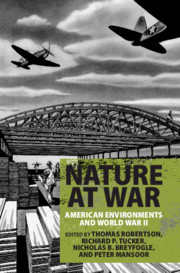Book contents
- Nature at War
- Nature at War
- Copyright page
- Contents
- Figures
- Tables and Charts
- Maps
- Contributors
- Preface
- Acknowledgments
- Introduction
- Part I New Weapons, New Spaces
- Part II Military Materials I (metals and energy)
- Part III Military Materials II (foods and plants)
- 5 Soldiers of the Soil
- 6 When Meals Became Weapons
- 7 From Field to Foxhole
- Part IV New Landscapes
- Part V New Frontiers
- Part VI Conservation
- Index
5 - Soldiers of the Soil
Labor, Nature, and American Agriculture during World War II
from Part III - Military Materials II (foods and plants)
Published online by Cambridge University Press: 25 March 2020
- Nature at War
- Nature at War
- Copyright page
- Contents
- Figures
- Tables and Charts
- Maps
- Contributors
- Preface
- Acknowledgments
- Introduction
- Part I New Weapons, New Spaces
- Part II Military Materials I (metals and energy)
- Part III Military Materials II (foods and plants)
- 5 Soldiers of the Soil
- 6 When Meals Became Weapons
- 7 From Field to Foxhole
- Part IV New Landscapes
- Part V New Frontiers
- Part VI Conservation
- Index
Summary
World War II sparked cultural and material transformations to American food and agriculture. Indeed, even before the United States formally entered the war in December 1941, American farmers played a critical role in supplying its Allies with foodstuffs. The war recast farming as an act of national security, for the animals and plants raised on American farms were critical to the war effort. Some wartime changes were short-lived. But others, such as the movement of farm laborers to industrial work in the West and North, and the technological developments facilitated by war-funded research, would have long-lasting effects. The war induced demand for farm crops and created labor shortages that required farmers to make new choices about how they tilled soil and which technologies they used to do it. Further, the higher farm prices farmers earned during the war years made it possible for them to invest in new technologies. By familiarizing farmers with new crops and technologies, the effects of World War II on the nation’s rural environment were profound, and they unfolded for decades after the Axis powers surrendered.
- Type
- Chapter
- Information
- Nature at WarAmerican Environments and World War II, pp. 149 - 175Publisher: Cambridge University PressPrint publication year: 2020



